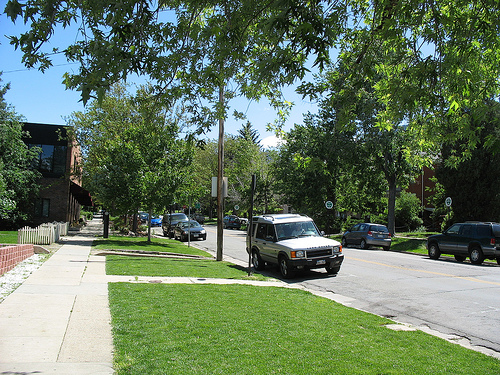UPDATE: We've summarized much of the series this article is part of in a new report, Policies for Shareable Cities: A Sharing Economy Policy Primer for Urban Leaders. Get your free copy here today.
A city’s safety and economic stability can be greatly enhanced if a spirit of community and sharing is fostered in every neighborhood.

A banner publicizes a block party in the Lower Irvington neighborhood of Portland, Oregon. Photo credit: JAGwired. Used under Creative Commons license.
Here are a handful of suggestions for ways that city policies and programs could foster community-building in neighborhoods:
-
Create a staff position focused on neighborhood community activities: Each city should hire at least one staff person dedicated to facilitating community-building activities in neighborhoods. This staff person would communicate regularly with neighborhood groups and associations, facilitate permitting and offer supplies for block parties, help organize emergency preparedness meetings, and give neighborhoods other support and resources. For example, in the City of Albany, California, there is a Community Services Manager that facilitates a handful of community-building activities such as neighborhood veggie swaps and block movie nights, for which the city lends neighborhoods a giant screen and projector.
-
Facilitate sharing and emergency preparedness simultaneously: In many respects, sharing and building community are the most important things we can be doing to prepare for emergencies. The City of Berkeley has a great tactic for getting neighborhoods organized: give them free stuff to share. The city awards caches of emergency supplies to neighborhood groups that have demonstrated that they have gotten organized and done some emergency preparedness planning and training.
-
Design neighborhoods for sharing: The layout and physical features of a neighborhood can greatly influence the ways that neighbors interact with each other. For example, social interaction is enhanced in neighborhoods with walkable spaces, plazas, parks, and narrower streets. Cities can enhance neighborhoods with initiatives to redesign streets, sidewalks, and intersections, and by imposing shareable design requirements on new planned communities.
-
Offer neighborhood sharing sheds and pods: In the same way that the City of Berkeley has offered special containers to neighborhoods for storing emergency supplies, a city could offer special containers or sheds where neighbors could store other shared items, such as the neighborhood lawn mower, vacuum cleaner, badminton set, and so on. It would be like having a mini tool library in every neighborhood. Cities could, for example, supply a container that is 6x6x6 feet (something similar to a POD), and designate a street parking spot for that container. The neighborhood group could complete an application with the city that demonstrates that it is organized and has a plan for managing the shared stuff.
-
Adopt a neighborhood social network platform: Recently, companies like NextDoor, rBlock, and OhSoWe have developed social network platforms for neighbors, and California cities like Redwood City and Palo Alto have begun to adopt these platforms on a city-wide basis or actively encourage neighborhoods to use them as a community-building tool. With such platforms, users get daily updates from their neighbors with information like: “Free plums from my tree!” “Has anyone seen my orange cat today?” “Can someone lend me a bicycle pump?” These platforms could grease the wheels of sharing in a neighborhood, and also give cities a more effective platform for communicating with residents.
-
Help neighbors remove fences: At least one city that we know of, Elgin, Illinois, has created an incentive program to help people remove chain link fences from their front yards. Removing fences from front or back yards helps to increase everyone’s access to open green spaces and facilitates connection between neighbors.
How else might a city encourage sharing in neighborhoods? Please post your thoughts below and help us build this collection of policy proposals. Thank you!
This post is one of 15 parts of our Policies for a Shareable City series with the Sustainable Economies Law Center:
- Car Sharing and Parking Sharing
- Ride Sharing
- Bike Sharing
- Shareable Commercial Spaces
- Shareable Housing
- Homes as Sharing Hubs
- Shareable Neighborhoods
- Shareable Workspaces
- Recreational and Green Spaces
- Shareable Rooftops
- Urban Agriculture
- Food Sharing
- Public Libraries
- The Shareable City Employee
- How to Rebuild the City as a Platform









